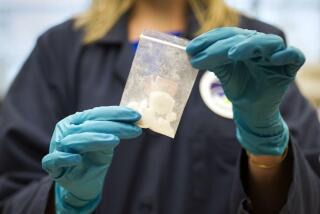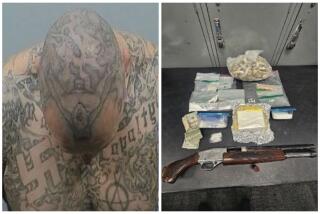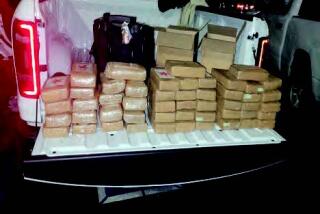4 Found Guilty as Suppliers of Major Drug-Making Ring : Courts: Inland Empire operation sold ingredients for manufacturing methamphetamine, prosecutors say.
Leaders of a major Inland Empire drug and money-laundering operation have been convicted of aiding and abetting the manufacture of methamphetamine, closing the doors on what prosecutors called one of the most sophisticated such organizations ever uncovered.
The last of the verdicts was handed down in U. S. District Court in Los Angeles on Tuesday after four weeks of jury deliberation. Four defendants were convicted, one was acquitted and the jury could not reach a verdict on a sixth. Charges against one defendant were dismissed.
Charles Wesley Arlt, the lead defendant in the case, was found guilty of masterminding a ring that supplied dozens of methamphetamine makers with so-called “precursor” chemicals needed to manufacture the drug. Three of his associates were convicted of money laundering and conspiracy to aid and abet the manufacture of methamphetamine, a powerful stimulant that is widely manufactured in the Inland Empire.
“This was one of the largest precursor organizations in the country,” said Frank Quintal, resident agent in charge at the Los Angeles office of the U. S. Drug Enforcement Administration, one of several agencies that participated in the case. “This may be the largest ever in this area.”
The Arlt case points to a new emphasis in the government’s long battle against methamphetamine, as drug agents turn more attention to organizations that supply the chemicals necessary for producing the drug.
“If you can cut off the drugs at this point, you keep methamphetamine off the streets,” said Assistant U. S. Atty. Melinda Haag, one of the prosecutors in the case. “This is probably a more efficient way to go.”
One defendant, Arlt’s aunt, was acquitted, and the jury could not reach a verdict on one other. The four who were convicted each face sentences of 30 years to life in prison.
Throughout the trial, Arlt denied the charges against him, saying the chemicals were not used for methamphetamine but rather for mining. His lawyer, Carmine Colucci, contended that the government “failed to prove its case” and that an appeal was certain.
The convictions cap a 17-month investigation initiated by San Bernardino police officers and San Bernardino County sheriff’s deputies that eventually included the DEA, the Internal Revenue Service, the California Bureau of Narcotics Enforcement and other agencies.
It also included one major setback: In March, 1991, a National Guard captain who was involved in the surveillance of the Arlt organization tried to sell the group an operations plan for $150,000. The captain, George Butterfield, was sentenced to 50 months in prison after the attempted extortion.
During a one-year period, Arlt and his associates bought and sold 96 drums of hydriotic acid. Although they said it was going to be used in mining, the government maintained that it was enough to “cook” 15,000 pounds of methamphetamine.
“Once we took (Arlt) down, we heard back from our sources that the cookers on the street were really having a hard time getting the chemicals they need to make the methamphetamine,” said Lt. Ray Rucker of the San Bernardino County Sheriff’s Department’s Narcotics Division.
The government also seized more than $1.5 million in assets from Arlt and his associates. Included were more than 50 vehicles, including two planes, a pair of Maserati stretch limousines, a Rolls-Royce Silver Shadow and a number of customized pickup trucks.
More to Read
Sign up for Essential California
The most important California stories and recommendations in your inbox every morning.
You may occasionally receive promotional content from the Los Angeles Times.











